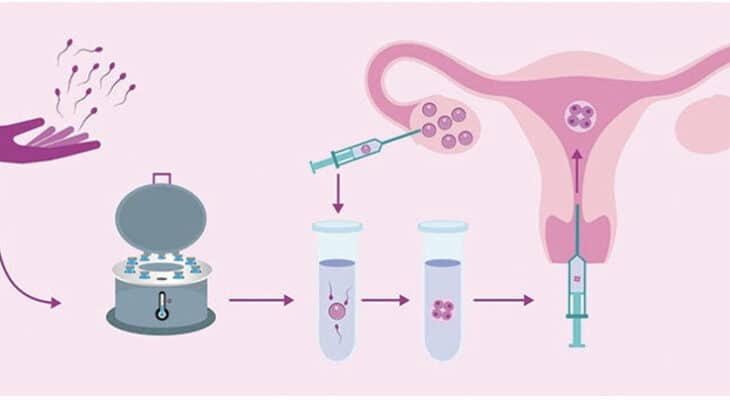
Delayed embryo transfer is a method used during in vitro fertilization (IVF) in which fertilized embryos are frozen and transferred to the woman’s uterus later. Delay frozen embryo transfers have become more popular thanks to advancements in embryo freezing, including the vitrification process.
“Delaying embryo transfer has many benefits, including lowering the risk of pregnancy in fresh embryo transfer IVF cycles, enabling the uterus atmosphere to return to normal after egg retrieval, and allowing genetic screening.”- Says Dr. Hrishikesh Pai who is working with one of the best IVF centre in India.
A freeze all IVF cycle involves freezing all embryos produced in an IVF cycle for possible future use, which is referred to as delayed embryo transfer.
What is Delayed Frozen Embryo Transfer?
Embryos produced in IVF can be transferred back into the woman’s uterus during the same ovulation cycle in which her egg(s) were retrieved and fertilized (approximately five days after fertilization) – called a fresh-cycle embryo transfer – or they can be frozen and transferred and implantation delayed until a later time – called a delayed embryo transfer.
In case of in vitro fertilization, the woman’s uterus is also under the influence of fertility drugs during fresh-cycle embryo transfers, resulting in more receptive ovaries and higher estrogen levels, all of which are detrimental to successful embryo implantation.
Delaying embryo transfer until the woman had begun a normal ovulation period was previously not a choice because the freezing phase for embryos resulted in less viable embryos and higher rates of embryo loss. Frozen embryo survival and success rates are now nearly equal to fresh embryos, thanks to advances in vitrification (a flash-freezing technique) and cryopreservation (freezing and storing).
Benefits of Delayed Frozen Embryo Transfer

Delayed frozen embryo transfer, also known as the freeze all procedure, occurs when a patient freezes all embryos during the first cycle of IVF. It has following benefits-
- Allows the uterus condition to return to normal after IVF therapy, allowing for natural embryo implantation.
- Reduces the chances of preterm labour, preeclampsia, and low birth weight in fresh embryo transfer IVF cycles.
- Allows for genetic testing, which improves the odds of a good pregnancy and a safe birth.
- Embryo freezing retains all viable embryos, making single embryo transfer simpler and significantly reducing the risk of multiple gestations (pregnancy with twins or more) and the related health risks.
- Reduces or eliminates the possibility of ovarian hyperstimulation syndrome (OHSS), which is a risk during fresh-cycle embryo transfers, during the transfer cycle.
- Multiple transfers are less costly than multiple fresh IVF periods.
An embryo free of genetic defects, the right timing so the embryo is in the uterus within the 8-10 day window of implantation after ovulation, and a uterus that is optimally ready to accept the embryo are all necessary for successful embryo implantation.
The need to move an embryo during the same induced ovulation IVF period when a woman’s eggs are harvested is removed when she has a frozen embryo. For the following factors, this extra time, or delayed implantation, improves the chances of a healthy pregnancy and birth:
The uterus of the woman has time to recover from the effects of IVF drugs, which promote egg development while altering the womb’s natural environment. These drugs affect the endometrium, which is the uterine lining where an embryo would implant.
During her next or future ovulation period, the woman will return for delayed embryo transplantation. Her uterus will be free of the side effects of IVF drugs and able to receive and nurture the embryo.
Genetic testing to improve the Chances of Success.
Genetic screening can determine genetically viable embryos for implantation, and it can be done on both fresh and frozen/thawed embryos. Any defect in an embryo’s genetic structure is a leading cause of implantation failure. This also removes the possibility of a child being born with a birth defect or a genetic mutation that makes them vulnerable to health issues.
Preimplantation genetic diagnosis (PGT-M) is a procedure that tests for a single genetic mutation and is often used when one (or both) of the parents has a confirmed or suspected genetic defect that may be present in their family history. Preimplantation genetic screening (PGT-A) searches for a number of genetic disorders, including Down syndrome, cystic fibrosis, and BRCA genetic defects, which place a mother and her children at risk for ovarian and breast cancer.
The risks of transferring a frozen embryo
IVF with delayed frozen embryo transfer, like fresh-cycle IVF, carries the risks of:
- Side effects of fertility drugs
- Some complications of egg retrieval include ovarian hyperstimulation syndrome and other ovarian hyperstimulation syndromes.
- Embryo shift spotting, cramps, or pain
- If more than one embryo is inserted, it is considered a multiple pregnancy.
There’s a chance that an embryo will be destroyed and need to be discarded during embryo freezing or thawing. However, as stated in the benefits section above, IVF with delayed frozen embryo transfer reduces some of the risks associated with fresh-cycle IVF.






















